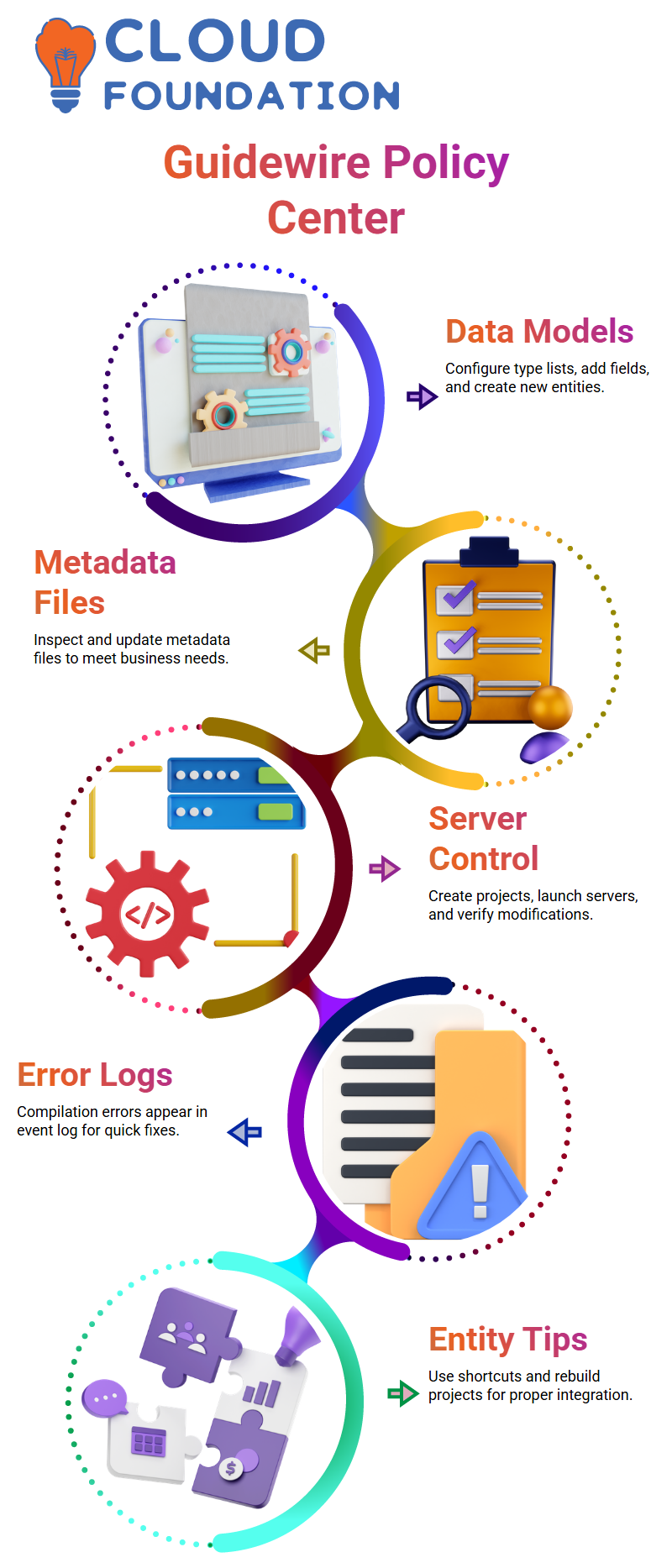Guidewire Policy Center Training Tutorial on Data Model & Entities
Introduction to Data Model in Guidewire Policy Centre
I’d want to take you through Guidewire Policy Center’s data model today. Although each application has its own unique data architecture, all Guidewire products—such as Policy Center, Billing Center, and Claim Center
share a similar platform layer that contains people and activities.
Understanding Data Objects in Guidewire Policy Centre
Data items and their connections make up a data model in Guidewire Policy Center.
A policy and an account, for instance, are two different types of data items.
A single account may have more than one policy. All Guidewire Policy Center entities are guaranteed to connect appropriately across various apps thanks to this structure.
Common Platform and Application Layers in Guidewire Policy Centre
A foundation platform layer is shared by all Guidewire apps, including Policy Center, Billing Center, and Claim Center.
Users, activities, and other essential entities are all part of this platform.
However, each application has its own configuration layer where entities are established, such as invoices and disbursements in the Billing Center or transactions, accounts, and rules in the Policy Center.
Entities and Fields in Guidewire Policy Center
Accounts, policies, and transactions are examples of entities in the Guidewire Policy Center.
Fields defining each entity’s attributes, including ID, name, creation time, assigned user, and vendor details, are included.
Additionally, fields include a variety of data kinds, including dates, numbers, texts, and Booleans.
You may provide a detailed description of every data object in the Guidewire Policy Center data model using these entity attributes.
Data Model Configuration in Guidewire Policy Center
Guidewire Studio allows you to directly configure data models. For every data object, you may define type lists, add fields, and create new entities.
To assist you in effectively managing the data model, Guidewire Policy Center additionally offers metadata and a data dictionary.

You may inspect metadata files for any entity, such as an account, and make the necessary changes based on business requirements.
Hands-On Server and Project Management in Guidewire Policy Center
You control your Guidewire Studio servers and projects in Guidewire Policy Center.
To make sure the data model updates appropriately, you create projects, launch servers, and verify modifications.
Errors during compilation are shown in the event log tool window, and the code generation tool aids in preserving consistency across entities.
After making modifications to the data model in Guidewire Policy Center, always confirm your changes.

Guidewire Training

Practical Tips for Managing Entities
Use shortcuts like Ctrl+Shift+N to locate certain data items while working with entities in Guidewire Policy Center.
All changes must pass via the appropriate metadata files, such as extension files ending in.etx.
This guarantees proper integration of your custom fields with the Guidewire Policy Center data model.
To implement changes in production after updates, rebuild the project and restart the server.
Extending Entities in Guidewire Policy Center
You may expand existing entities in the Guidewire Policy Center using the data model. For instance, ETI and ETX files may be used to expand the contact object.
The ETX extension file is where you make your modifications, while the ETI file includes metadata.
The Guidewire Policy Center has subcategories for each entity, including Person, Vendor, Company, and Legal Venue.
Understanding the parent-child bond is essential in this situation.
For instance, the Person entity is a subtype of Contact, and it may also have further subtypes such as User Contact, Person, or Adjudicator.
Comprehending subclasses facilitates the proper extension of Guidewire Policy Center entities.
Each field within an entity has an attributes pane showing its name, type, and nullability. The ETI and ETX files display columns, array keys, foreign keys, and type keys.
Working with XML and SBT Templates
ETX files may be saved in the XML format using the Guidewire Policy Center. SBT templates, which are standard-based templates used by some corporations, could also come up.
These templates provide smooth SOAP or REST communication integration with other systems.
The Guidewire Policy Center often employs XML for code merging and transmission across systems.
Effective setup requires an awareness of XML structure, and the communication templates guarantee correct data flow across other systems.
Attributes and Fields in Guidewire Policy Center
The Guidewire Policy Center has characteristics for every entity field.
For instance, you may add additional columns of certain kinds, such as text, integer, decimal, or date, to the Phone Number field, which is a data field.
Use of an underscore with ‘ext’ is advised by naming standards to make it simple to identify expanded columns.
For example, we may add fields like Web Address, Vendor Code, Customer Rating, or Strategic Partner when we expand the Contact object.
To guarantee correct data treatment, metadata has been specified for each column in the Guidewire Policy Center.
To assist you in properly tracking and configuring fields, the Guidewire Policy Center’s element pane shows all columns along with their properties.
If the business circumstance calls for it, you may include up to five more columns in a single extension file.
Creating and Extending Entities in Guidewire Policy Center
Creating entities correctly is the first step in working with them in Guidewire Policy Center.
In order to fully comprehend each component, I always begin by building the entity.
After the object is created, I concentrate on interaction, extension, and figuring out whether it is final or expandable.
Although a final entity cannot have subtypes, you may modify it to be extensible at any point in the Guidewire Policy Center if you want flexibility.

File Extensions in Guidewire Policy Center
File extensions like ETX and ETI are essential while working with Guidewire Policy Center.
ETX files permit extensions, but ETI files provide the basic entity. The main tag for each new entity is usually “entity” or “extension.”
Once an entity has been created, I review its components to see if it needs to be extended to ETX.
This method maintains the data in the Guidewire Policy Center organized and manageable.
Adding Columns and Data Types in Guidewire Policy Center
It’s easy to add columns in Guidewire Policy Center. For example, I provide text columns for summaries and date columns for interaction dates.
I always verify the data types, setting widths and using Varchar for strings. This prevents mistakes later on and guarantees the data functions properly inside Guidewire Policy Center.

Guidewire Online Training

Validating and Deploying Changes in Guidewire Policy Center
I always confirm the modifications in Guidewire Policy Center after establishing entities and connections. I restart the server after stopping it and building the project.
This ensures that the data model modifications are implemented appropriately.
I may check the data dictionary and make sure that all entities and extensions are current by using the GWB region-dictionary command.
Accessing Data and Metadata in Guidewire Policy Center
I often have to consult the data dictionary in Guidewire Policy Center in order to see where the data is kept.
I can simply see entities, fields, and information using Guidebase Studio. Base application data is shown in green, while new data is shown in blue.

I can easily tell which data in Guidewire Policy Center is pre-existing and which was just added thanks to this color labeling.
Working With Multiple Studios in Guidewire Policy Center
I sometimes use my PC to collaborate with many studios. Once the server is running, I can see the interaction entities in real time and manage numerous data sources using Guidewire Policy Center.
I can experiment with various data types and entity names thanks to this flexibility without having an impact on the main system.
Practical Tips
I usually utilize multiple data kinds, such as strings, decimals, and bit types, while expanding entities in Guidewire Policy Center in order to satisfy diverse needs.
Every time you make changes, I advise pausing the server, recreating the project, and starting it again.
This process guarantees data integrity and maintains Guidewire Policy Center operating efficiently.

Navya Chandrika
Author
